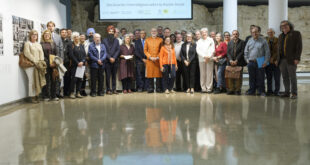ONE LESSON WE CAN LEARN FROM OUR ENEMIES
Today is Yom haShoa. The day in which we remember the brutal extermination of 6 million Jews at the hands of the Nazi murderers and their collaborators.
Last night I gave a class about the effect the Shoah had on the Sephardic communities around the world. I mentioned first the best known cases. That is, all the Sephardic communities in Europe, the Netherlands, France, Bulgaria, Yugoslavia and Italy, suffered the same fate as the Ashkenazi communities in Europe. Probably the most shocking case was that of the community of Thessaloniki in Greece, where more than 54,000 Jews, 95% of its population, were exterminated in Auschwitz (see here). My first reflection is that we can learn one thing from our enemies: we are ONE united people. And that there are not, nor should there be, differences between Sefaradim, Ashkenazim; more religious or less religious. We must do the impossible to stay together, and feel and behave as members of the same family.
THE JEWS OF MOROCCO AND ALGERIA
The main topic I spoke about last night was the impact of the Shoah on Jewish communities in North Africa: Morocco, which in 1940 had a population of 200,000 Jews. Algeria, 120,000 Jews. Tunisia, 80,000 Jews, and Libya, 30,000 Jews. The first three states were under the French protectorate and Libya under the Italian protectorate. France was occupied by the Nazis in 1940, what is known as ” Vichy France”. The Germans ruled France, its colonies, and also its protectorates. This included: Morocco, Algeria and Tunisia. The infamous “Statut de Juifs” were established in Morocco and Algeria, which allowed to confiscate the properties of the Jews, extremely restrict their activities and access to education, etc. The Germans also established about 30 labor camps to build the trans-Sahara highway, and for that they recruited some 4,000 Jews from Morocco and about 1,000 Jews from Algeria. It should be noted that there was a huge difference between these camps and, for example Auschwitz or Bergen-Belsen. In the “labor camps” of North Africa, initially, only adult men fit for work arrived. Dozens of them died due to the lack of sanitary conditions of the jobs, the scorching heat, disease, etc. But the vast majority survived. The European camps, on the other hand, were “extermination camps.” Children, the elderly, and women and men who were unable to work were immediately exterminated in the gas chambers. And men and women fit for work were force to work ultimately to be killed in the process. This horrible strategy, not known enough, has a “name” in the German language. The expression is: Vernichtung durch Arbeit, “exterminating (Jews) through forced labor”.
Back to North Africa, providentially, on November 8, 1942, before the Nazis could carry out the process of deportation and extermination of the Jews, the allies led by General Montgomery reached the shores of Algeria and Morocco and were able to defeat General Rommel’s Nazi forces in an military assault known as “Operation Torch” (see map above).
THE OLDEST JEWISH SYNAGOGUE OUTSIDE ISRAEL?
Tunisia is a separate story. Tunisia was the only country in North Africa that was directly occupied by the Nazis. To begin, let’s say that the Jewish population of this country, the smallest country in the region, constituted 15% of the total population. The Jews lived in Tunis, the capital, and on the famous island of Djerba. According to tradition, a group of Cohanim (priests) serving in the Temple of King Solomon escaped to Djerba when the Great Temple of Jerusalem was destroyed in 586 BCE, they took some stones from the ruins and used some of those stones to build a Synagogue. To this day, most Djerba’s Jews are Cohanim (their old priestly DNA was recently confirmed). And Djerba is one of the few Jewish communities that still survive in the Arab world. A day after the Torch Operation began, on November 9, 1942, the Germans occupied Tunisia. Rommel’s idea was to regroup together in that country and from Tunisia, repel the Allied forces arriving from Morocco and Algeria, and the British forces arriving from Egypt. Within a few days, and despite the fact that Germans were busy fighting the Allied forces, the Germans ordered the leaders of the Jewish community to give them all the details of their community. Thousands of Jews were taken to the labor camps to build military roads (the vast majority survived) and more than 200 Tunisian Jews were transferred directly to Europe, where they were exterminated in the extermination camps.
B”H in May 1943 the allies defeated and expelled the Germans from Tunisia, preventing the loss of a much greater number of Jewish lives.
I will refer to the history of the Libyan Jews during the Holocaust B”H tomorrow.
WHO WAS NOT INCLUDED IN THE FINAL SOLUTION?
I would like to end with a final reflection. On January 20, 1942 the infamous Wannsee conference took place near Berlin. At that conference (see here) the senior Nazi officials met for the purpose of evaluating and strategizing the final solution to the Jewish problem. There it was mentioned, among other things, that the number of Jews to be eliminated in France was 700,000 Jews. But in France there were only 350,000 Jews! Historians say the only way to understand this difference in numbers is that the Nazis planned to exterminate all Jews from countries that were under the French protectorate: Morocco, Algeria, and Tunisia….
I always defined myself as “a Holocaust survivor.” The simple reason is that, as it happened with North Africa, the extent of the Nazis’ final solution did not end in Europe. If HAS VESHALOM the Nazis had triumphed in Europe, then the Jews of North Africa, the Middle East, and the Americas would also have been subjected to the final solution.
We are all Shoah Survivors
IZKOR

Rab Yosef Bitton
Fuente: halakhaoftheday.org
 eSefarad Noticias del Mundo Sefaradi
eSefarad Noticias del Mundo Sefaradi

